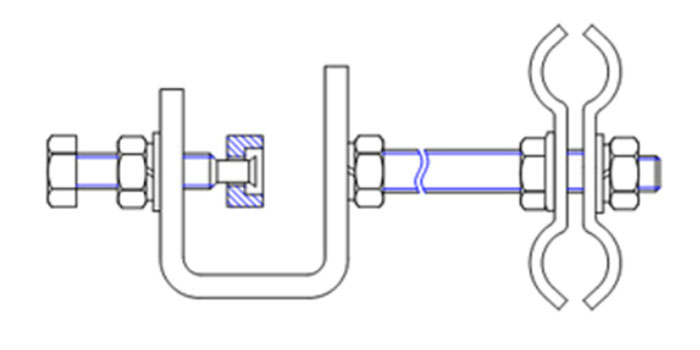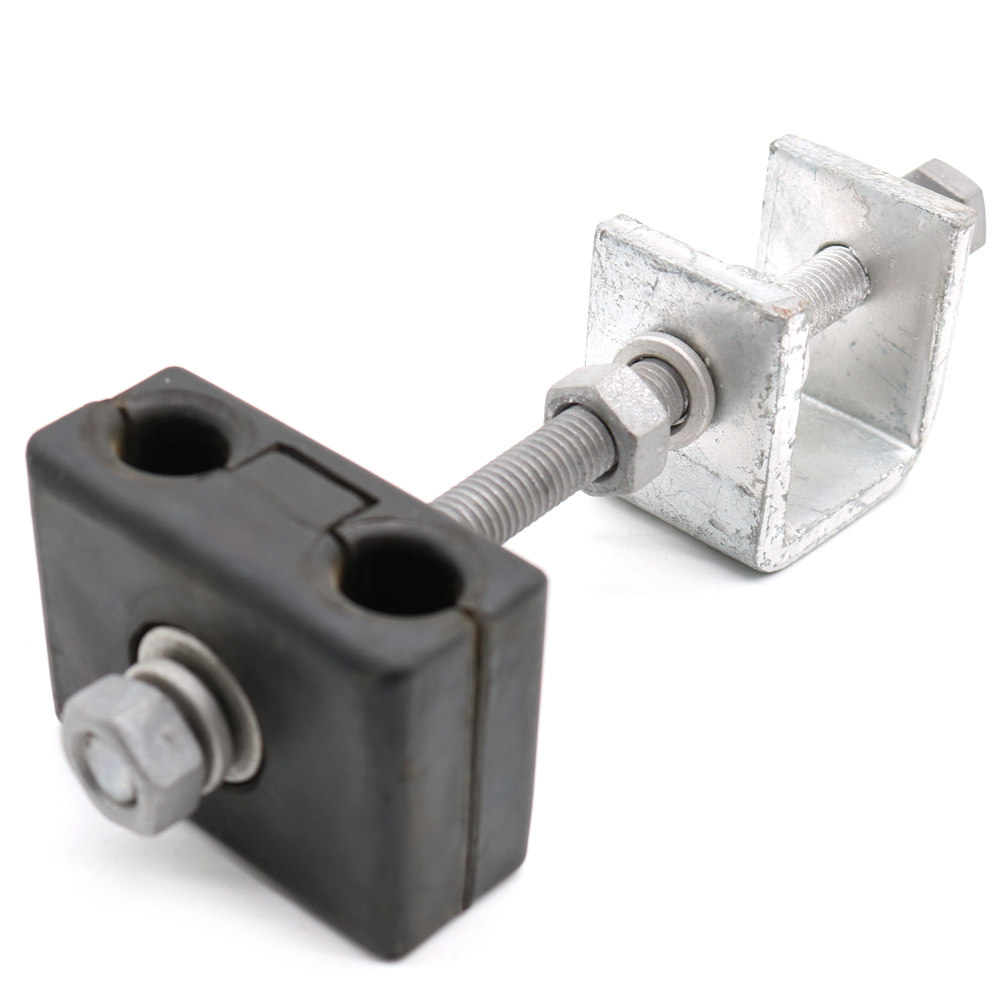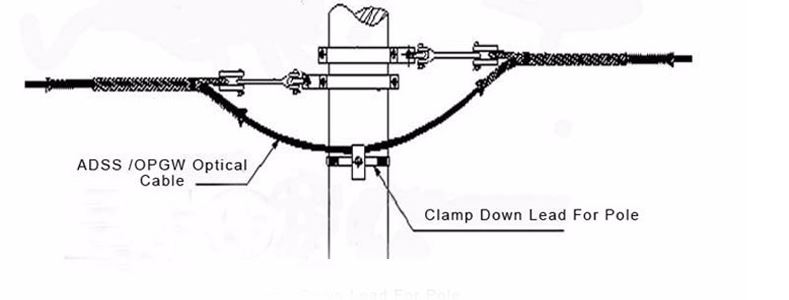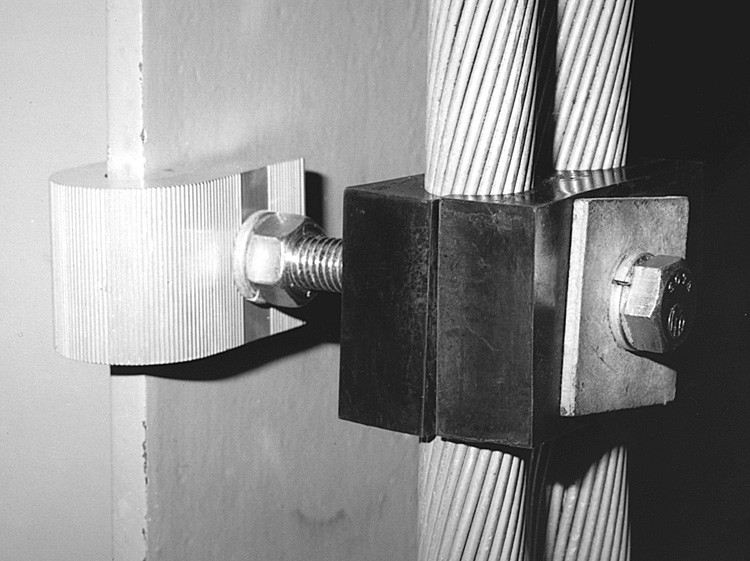A downlead clamp is a specialized bracket attached to a towering transmission line. It helps to safeguard and secure cables dropping from the power pole. Its primary role is to prevent the cable from swaying in the wind. Too much sway is from excess wind or storms which could lead to damage. Downlead clamp also distributes the weight of the cable to reduce stress on the cables and attachment points. The clamp maintains proper spacing between different cables running down the structure. This is to reduce the risk of entanglement. Its design varies depending on the specific cables type and application. It has a clamping mechanism and attachment points for fixing to the tower. Downlead clamps are from materials such as galvanized steel and other weather-resistant materials. This is to offer strength and durability to the structure.

Types of downlead clamp
There are various types and designs of downlead clamp to use in overhead transmission lines. each has designs to accommodate specific conductor configurations, installation requirements and environmental conditions. Also, consult with industry experts for guidance on the best type for your applications. The following are the common types of downlead clamps.

- Wedge downlead clamp – these clamps use a wedge-shaped component to secure the conductor in place. It creates a secure and tight connection without damaging the conductor.
- Insulated downlead clamp – these clamps feature insulation materials. They prevent electrical contact between the conductor and the support structure.
- Bolted downlead clamp – this features a bolted connection mechanism to secure the conductors. It has two halves bolted together around the conductor to provide a strong and reliable grip.
- Spring-loaded downlead clamp – this mechanism applies constant pressure to the conductor. It helps ensure a secure grip while allowing some flexibility.
- Helical downlead clamp – this features a helical design that wraps around the conductor. This helps to provide a secure grip while allowing for some movement.
- Parallel groove downlead clamp – this features grooves for easy installation and adjustment. This is mainly for parallel groove conductors.
- Compression downlead clamp – this uses compression fittings to secure the conductor in place. They find use in high-voltage applications where a reliable and low-resistance connection is necessary.
Components of downlead clamp
Downlead clamps consist of several components designed to grip the conductor while providing mechanical support. The available components vary depending on design and type of downlead clamp. The components collaborate to form a clamp that supports the conductor and ensures safe and reliable operation. The following are the various components of the downlead clamp.

- Clamping mechanism – this is the main component of the clamp responsible for gripping the conductor. It includes bolts, wedges, springs or compression fittings. Their designs apply pressure and hold the conductor in place without damage.
- Clamp body – this is the main structural component of the clamp that houses the clamping mechanism. It is from strong materials that provide support to the conductor.
- Hardware – the clamps include components such as bolts, nuts, washers and screws to assemble and secure the clamp. The fittings are from corrosion-resistant materials to withstand environmental conditions.
- Gripping surfaces – this comes into direct contact with the conductor and have designs to provide a secure grip without damage.
- Insulation – these are useful to prevent electrical contact between the conductor and the supporting structure.
- Mounting bracket – the clamps may mount on support structures to provide extra stability and support to the clamp assembly.
- Corrosion protection – the clamps have coatings to provide corrosion protection. This helps prolong the lifespan of the clamps.
Downlead clamps for ADSS cables
ADSS cables are All Dielectric Self-Supporting cables used on overhead transmission lines. They require use of specialized downlead clamps to ensure their safe and controlled descent. ADSS cables depend on their own non-metallic structure for support. The clamps have designs to support the characteristics and requirements of ADSS cables. They also help to provide a secure attachment and strain relief in various installation cases. Additionally, it is advisable to consult with industry professionals for guidance on the best downlead clamp for your ADSS cables. The following are the common downlead clamps for your application.

- Non-metallic construction – the clamps should be from high strength polymers or composite materials. This is to offer high mechanical strength while being non-conductive.
- Gentle grip design – downlead clamps for ADSS cables should have a gentle grip design. This design reduces stress concentrations on the cable and prevents damage to the fibers.
- Tension distribution – ADSS cables have designs to support their weight and withstand mechanical stresses. Their design helps to distribute tension along the length of the cable and reduce stress.
- Suspension configuration – the clamps may have designs for suspension configurations. It also depends on the installation requirements. This is to provide secure termination at the end of the cable run.
- Strain relief – the clamps should incorporate strain relief features to accommodate the movements. This is while reducing stress on the cables and its attachments.
- ADSS hardware compatibility – the cables should be compatible with other hardware and accessories. This is including suspension brackets, pole fittings and cable grips.
- Ease of installation – the cables need specialized tools and techniques for easy installation.
Functions of downlead clamps
Downlead clamps offer various important functions to overhead transmission lines. The functions ensure the safe and reliable operation of the transmission infrastructure. They are important in the performance and reliability of overhead transmission lines. This is by attaching, supporting and protecting electrical conductors or cables. The following are the various functions of downlead clamps.

- Corrosion protection – some of the clamps have corrosion-resistant materials. They help protect against environmental factors. This is including moisture, salt spray and chemical exposure. This helps to increase the lifespan of the clamps.
- Electrical insulation – the clamps provide electrical isolation between the conductors and the support structures.
- Mechanical support – the clamps provide mechanical support to the conductors or cables. This promotes the even distribution of weight along the length of the transmission line. This prevents sagging which can lead to mechanical damage.
- Alignment – downlead clamps help maintain the proper alignment of the conductors. Alignment allows efficient power transmission, reduces losses and ensures the integrity of the electrical system.
- Strain relief – the clamps also allow for some movement of the conductors to hold various factors. They include thermal expansion and contraction, wind-induced movement and structural settling.
- Secure attachment – the primary function of the clamps is to attach electrical conductors to supporting structures. The clamps grip the conductors to prevent them from detaching under mechanical stresses.
Benefits of using downlead clamps
Downlead clamps provide various benefits in overhead transmission lines. This contributes to the overall performance, reliability and safety of the transmission infrastructure. This includes secure attachment, support and protecting electrical conductors. Additionally, it is advisable to check the benefits and limitations of each downlead clamp before selection. The following are the benefits of using downlead clamps in your application.

- Installation ease – the clamps have designs for easy and efficient installation to reduce the installation time and costs. This contributes to the efficiency of the transmission line installation process.
- Secure grip – downlead clamps hold the cables in place to prevent swaying, bouncing and unexpected movement that could lead to damage or disconnection.
- Alignment – the clamps help to maintain the proper alignment of the conductors along the transmission line. This is essential for efficient power transmission, reducing losses and ensuring reliability of the electrical system.
- Cable management – the clamps maintain proper spacing between different cables to prevent the risk of entanglement, short circuits or power outages.
- Organized infrastructure – proper cable management simplifies maintenance and inspection. This leads to increased operational efficiency and reduced downtime.
- Strain relief – downlead clamps offer strain relief to the conductors to allow for some movement to accommodate various factors. This is including thermal expansion and contraction, wind-induced movement and structural settling.
- Improved reliability – the secure and controlled descent reduces the risk of disruptions and power outages. This ensures the consistent and reliable power transmission leading to economic benefits.
- Durability – the clamps are from strong materials that withstand harsh weather conditions and require minimal maintenance. This reduces the life costs of the clamps and the infrastructure
- Efficient transmission – use of these clamps reduces friction and wear and improves energy efficiency. This leads to reduced consumption of resources and lower emissions.
Frequently asked questions
A downlead clamp is a device used to guide and support cables from high transmission lines. they prevent swaying, bouncing and entanglement to ensure safe and controlled descent of cables.
Downlead clamps provide numerous benefits including safety and security, operational efficiency, cost effectiveness and environmental impact.
Consider factors such as cable type and diameter, application, load capacity and environmental impacts. This helps to ensure the right selection of the clamp for your application needs.

